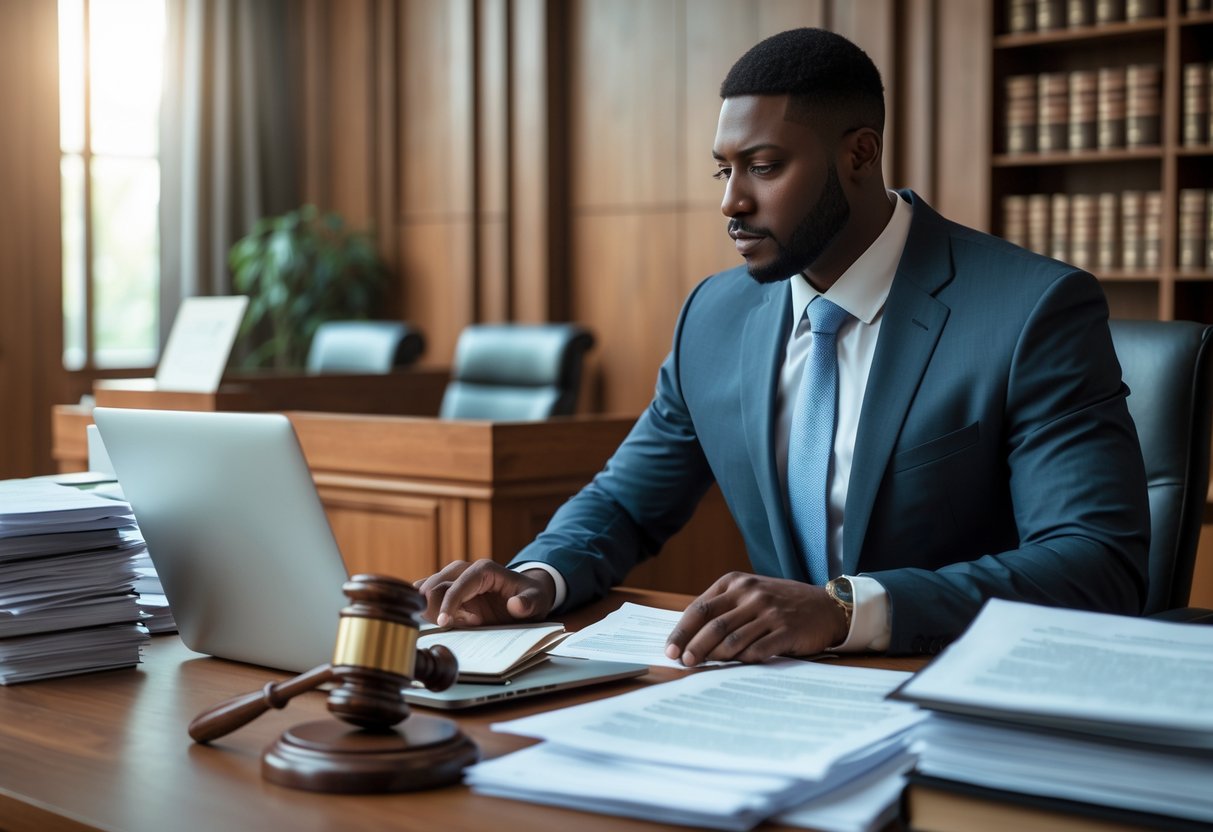After a trial ends, the case is not always over. This is where post-trial motions become important. Post-trial motions give us a chance to challenge the outcome or fix legal mistakes before the case moves to an appeal.
These motions can ask the court to reconsider its decision, order a new trial, or even change the result entirely. Understanding how post-trial motions work helps us know what options we have after a trial wraps up.
Knowing about these tools can give us more control and confidence as a case moves forward. If we want to protect our rights and make sure justice is served, understanding post-trial motions is a key part of the process.
Fundamentals of Post-Trial Motions

Post-trial motions are requests made after a trial ends, but before the case is fully closed. They serve different functions, from challenging mistakes to asking for a new outcome, based on the rules of court and established legal principles.
Definition and Overview
A post-trial motion is a formal request to the court to review or change a rulings made at trial. We usually file these motions after a verdict but before final judgment. They are key legal tools in any type of litigation.
These motions come in various forms, such as:
- Motion for Judgment Notwithstanding the Verdict (JNOV)
- Motion for a New Trial
- Motion to Alter or Amend Judgment
By filing post-trial motions, we ask the judge to fix errors, reconsider decisions, or even set aside the jury’s verdict. Post-trial motions help ensure fairness and allow us to address issues before starting the appeal process.
Importance and Role in Litigation
Post-trial motions play a central role in the legal landscape of litigation. They give us a final chance to challenge decisions made during the trial stage.
These motions allow us to:
- Point out clear legal or factual mistakes.
- Address new evidence discovered after the trial.
- Request changes or corrections to the judgment.
They help protect our rights within the trial procedure and can avoid the costs and delay of an appeal. If the trial judge grants a post-trial motion, it can change the outcome without needing to move to higher courts. This is important for both sides to understand as they plan their next steps.
Statutory and Procedural Foundations
Post-trial motions are governed by specific laws and rules. The main sources include federal and state statutes, as well as court procedural rules. For example, in federal court, Rules 50 and 59 of the Federal Rules of Civil Procedure guide us on when and how to file these motions.
Statutes often set strict deadlines sometimes as short as 10 or 28 days after the verdict. We must follow these procedures exactly, or we risk losing our right to challenge trial results. Courts demand precise compliance, from how motions are written to the evidence or arguments included.
Understanding and following these foundations is critical for post-trial success. The legal principles behind these rules ensure that litigation is resolved fairly according to well-established procedures.
Common Types of Post-Trial Motions
After a trial ends, both parties can ask the court to reconsider parts of the case. These requests are called post-trial motions, and they can change or even overturn the original result. Courts use these options to correct errors and make sure the outcome is fair.
Motion for New Trial
A motion for a new trial is a formal request asking the judge to set aside the jury’s verdict and hold a new trial. We usually file this motion if we believe a legal error happened during the original trial. Common reasons include improper jury instructions, misconduct by a party or juror, or new evidence that was not available before.
If the court grants a new trial, the case is tried again as if the first trial never happened. New trials are not granted often. The judge must agree that the mistake was serious enough to affect the outcome. This motion is important because it gives us another chance to argue the case when fairness may have been at risk.
Judgment Notwithstanding the Verdict (JNOV)
A Judgment Notwithstanding the Verdict (JNOV) asks the court to override the jury’s decision and enter a different judgment. We might file a JNOV if there was not enough evidence to support the jury’s finding or if the verdict goes against the law.
For example, if the jury returns a verdict that no reasonable group could support based on the facts, JNOV is an option. Courts are cautious with this motion because it limits the role of the jury, but it is critical if a verdict is clearly unsupported.
The judge will review the evidence and legal standards before deciding. If granted, JNOV can result in a total reversal or modification of the verdict. This can also lead to a new trial if the judge thinks another jury should look at the facts.
Motion to Vacate Judgment
A motion to vacate judgment asks the court to cancel or “vacate” its final judgment. We use this when we believe there was a fundamental problem with how the judgment was entered. Reasons may include lack of jurisdiction, fraud, or a clerical error.
This motion is different from an appeal. Instead of asking a higher court to review the case, we are asking the same trial court to fix the judgment. The court may hold a hearing before deciding.
If the motion is approved, the court may set aside the judgment fully or in part. This tool helps make sure the court’s record is accurate and fair, correcting mistakes that could harm a party’s rights.
Motion to Alter or Amend Judgment
With a motion to alter or amend judgment, we ask the court to change its judgment to correct errors or consider new evidence. This motion is usually filed after the final judgment but before the deadline to appeal runs out.
We might use this motion if there was a mistake in the amount of damages, the judge misunderstood the law, or if important new facts come to light. The request can lead to changes in the judgment, such as adjusting the damages or changing terms of the decision.
Filing this motion is often a requirement before we can appeal some issues. It allows the trial judge to address problems directly before a higher court becomes involved. This keeps the process efficient and gives both sides a chance for correction.
Grounds for Filing Post-Trial Motions
Post-trial motions are important because they allow us to address mistakes and unfairness that occur during a trial. They help make sure the outcome is based on law and truth rather than errors or improper conduct.
Legal Errors During Trial
Legal errors are one of the most common grounds for filing post-trial motions. These errors happen when the judge makes a wrong decision about the law during the trial. For example, if a judge allows evidence that should not have been admitted, it can impact the final verdict.
We might also file a motion if the judge gives the jury the wrong instructions. Incorrect legal instructions can confuse the jury and lead to a mistake in their decision. If these errors are serious enough to affect the outcome, we can ask the court to correct them through a post-trial motion.
Key points:
- Wrongful admission or exclusion of evidence
- Improper jury instructions
- Incorrect application of laws
Legal errors must be substantial. Minor mistakes usually do not justify overturning a verdict.
Newly Discovered Evidence
New evidence can sometimes be found after a trial ends. If we find evidence that we could not have discovered with reasonable effort before or during the trial, we might have grounds for a post-trial motion. The evidence must be important enough to possibly change the verdict.
There are rules for this ground:
- The evidence must be new and not something we already knew about.
- It must be relevant and material to the main issue at trial.
- It must not be just for the purpose of challenging the witness’s character.
For example, a new witness or document might show that someone else committed the crime or prove an important fact. We must show that this evidence would likely lead to a different outcome.
Juror and Procedural Misconduct
Juror misconduct happens when a juror acts against the rules of the court. Examples include talking about the case outside of deliberations, using social media to discuss the case, or being dishonest during jury selection.
Procedural misconduct means not following required trial processes. This can include things such as lawyers hiding information or failing to follow court orders.
These problems can result in an unfair trial and a miscarriage of justice. If we can prove misconduct, we may file a motion to have the verdict set aside or a new trial granted.
Procedural Irregularities
Procedural irregularities refer to mistakes in how the trial was carried out. This includes errors in filing court documents, not following deadlines, or failing to notify parties of important actions. These irregularities can hurt our chances of a fair trial if they affect our rights or the outcome.
Some irregularities are minor and do not matter. But if the mistake has a real impact on the result of the trial, it may be strong grounds for a post-trial motion.
Below is a simple table showing examples:
| Type of Irregularity | Possible Effect |
|---|---|
| Missed deadline | Loss of argument right |
| Incorrect notice | Party left uninformed |
| Defective filings | Argument ignored |
We use these grounds to ensure the trial was fair according to law and proper process.
Procedural Requirements and Timing
Post-trial motions require us to carefully follow court rules and pay close attention to legal timelines. Missing a deadline, failing to notify the parties involved, or not following statutory law can cause our motion to be dismissed.
Filing Deadlines and Jurisdiction
Every court sets specific deadlines for filing post-trial motions. For example, in many jurisdictions, a motion for a new trial or judgment notwithstanding the verdict must be filed within 10 to 30 days after the judgment.
If we miss these deadlines, the court often loses jurisdiction. This means the judge cannot consider our motion, even if we have good reasons. Timing rules are strict and courts will not grant extensions unless the law allows for special circumstances.
| Motion Type | Typical Deadline |
|---|---|
| New Trial | 10-30 days post-judgment |
| Judgment NOV | 10-30 days post-judgment |
| Motion to Amend | 10-30 days post-judgment |
These timeframes may differ based on state or federal law, so we must check the local rules for each case.
Notice and Service of Post-Trial Motions
Aside from filing with the court, we must also give clear notice to all parties in the case. Most courts require us to serve the motion and any supporting documents to the opposing side using approved methods like mail, in-person delivery, or electronic service.
Proper notice is important because it allows the other parties time to respond. If we fail to serve notice correctly, the court may reject our motion, no matter how strong our arguments.
The court will often require proof of service that is, paperwork showing exactly when and how documents were served. Failing to follow these steps can cause delays or dismissal of our motion.
Compliance with Statutory Law
Our post-trial motions must follow relevant laws set by legislatures, such as the Federal Rules of Civil Procedure or state statutes. These laws often state what issues can be raised in post-trial motions, what forms to use, and which evidence is allowed.
Courts will check if our motion meets the legal requirements. For example, if the law requires signatures, supporting affidavits, or specific language, we must include all these elements. Missing something could make the motion invalid.
We should always check both the court’s rules and any governing statutes before filing to make sure our motion is both timely and complete. If we follow the law closely, the court is more likely to hear and rule on our post-trial motion.
Responding to Post-Trial Motions
When post-trial motions are filed, our response must be direct and well-supported. Addressing these motions effectively may include objecting to claims, presenting evidence, and advocating through oral arguments.
Objections and Counterarguments
We should carefully review the motion and identify any legal or factual errors. If the opposing side misunderstands the law or misstates facts, we need to clearly point this out to the court.
It’s helpful to use lists or tables to organize our arguments:
| Claim in Motion | Our Objection |
|---|---|
| Evidence was excluded | Objection: Evidence irrelevant |
| Verdict unsupported | Objection: Evidence supports verdict |
We also need to back objections with case law or statutes whenever possible. Legal representation often drafts these responses to make sure objections follow court rules.
Evidence and Oral Arguments
We should include any important evidence that supports our position. Sometimes, new evidence is not allowed, so we focus on what was already presented at trial.
Oral arguments let us explain our position directly to the judge. These arguments help clarify points that may not be obvious from written documents.
Often, we prepare notes and highlight key facts that support our case. Good preparation ensures we answer questions from the judge quickly and clearly.
Judicial Discretion and Rulings
After hearing both sides, the judge decides whether to grant or deny the post-trial motion. Judges have broad discretion in making these decisions.
Our response should respect the court’s authority while persuasively making our case. Being polite and clear in our presentations is important.
Sometimes, judges may ask questions or request more information before ruling. We need to be ready to respond quickly to any follow-up requests or instructions from the court.
Impact of Post-Trial Motions on Appeals
Post-trial motions play an important role in shaping what can be challenged on appeal. These motions also help establish the record that an appellate court will review.
Preserving Issues for Appeal
We must raise certain objections or arguments in post-trial motions to preserve them for appeal. If we skip a key issue, the appellate court may decide not to review it. Preservation means giving the trial court a chance to fix or address any errors before moving to the appellate level.
Some common grounds for appeal include errors in jury instructions, improper admission of evidence, or insufficient evidence to support a verdict. By including these specific issues in our post-trial motions, like motions for a new trial or judgment notwithstanding the verdict, we document them in the record.
If an issue is not clearly presented at this stage, it is often impossible for us to raise it later. Courts expect us to be specific when stating errors. The process ensures that appellate courts do not become the first venue to address problems.
Appellate Review and Process
Once we file our post-trial motions and the trial court makes a decision, we can seek appellate review if needed. Appellate courts look closely at the record created during trial and post-trial proceedings, not at new evidence or outside material.
The record on appeal is made up of transcripts, evidence, and filings from trial, including the post-trial motions. Appellate courts use this record to review whether the trial court made legal errors.
The appeals process focuses on legal mistakes, not factual disagreements. Appellate judges do not retry the case. Our success often depends on how thoroughly we presented and explained our objections in post-trial motions.
Notice of Appeal and Appellate Briefs
To start the appeal process, we must file a notice of appeal within a specific deadline after the trial court’s final decision on the post-trial motion. Missing this deadline usually ends our chance to appeal.
After giving notice, we need to submit appellate briefs. These are written arguments explaining which errors we believe happened and where they were raised in the record. Including citations to the relevant post-trial motions or trial transcripts is key.
The appellate court relies on our briefs to understand our position. Both sides appellant and appellee submit briefs for the appellate court to review before making a decision. This written process is central to how appellate courts decide cases.
Strategic Considerations for Legal Practitioners
Successful post-trial motions require us to make well-timed decisions and carefully evaluate our options. Our choices have a direct effect on legal strategy, research, and the result of the trial.
Selection of Appropriate Motions
We need to know which post-trial motions are best for our specific case. Some examples include motions for a new trial, motions for judgment notwithstanding the verdict (JNOV), and motions to alter or amend the judgment. Each has its own legal requirements and deadlines.
When deciding which motion to file, we should review the trial record for errors or issues that hurt our case. Timeliness is important; missing a deadline can bar our request. Making the right choice can correct a legal mistake or even change the trial outcome.
Key questions to guide selection:
- Did the judge make a legal error?
- Was the jury’s decision unreasonable or unsupported by evidence?
- Is there new evidence that could change the result?
By asking these questions, we can select the motion with the best chance of success.
Litigation Strategy and Legal Research
Our litigation strategy should include a strong foundation of legal research. We must review statutes, case law, and rules governing post-trial motions to ensure compliance. Careful research helps us present sound arguments based on established law.
We often use checklists or tables to keep track of:
- Filing deadlines
- Supporting documents needed
- Relevant case law citations
| Task | Importance |
|---|---|
| Research case law | Supports legal arguments |
| Check all deadlines | Avoids dismissal |
| Gather trial record | Finds legal errors |
We need to be clear, concise, and organized in our motions. Good legal research and careful presentation give us the best chance of persuading the judge.
Implications for Trial Outcomes
Filing the right post-trial motion can change the outcome. It may lead to a new trial, a different judgment, or even settlement talks.
Challenging errors can show our commitment to effective legal representation. If we win a motion, it can prevent unfavorable results from becoming permanent. On the other hand, losing a motion may limit our choices for appeal.
We must consider how our actions affect the client and the case as a whole. The way we handle post-trial motions is an important part of the overall litigation strategy and can shape the final result.
Post-Trial Motions in Complex Litigation
Complex litigation often involves many parties, large amounts of evidence, and high financial stakes. The procedures for post-trial motions can be different and more challenging than in standard cases.
Unique Issues in High-Stakes Cases
When the stakes are high, post-trial motions can shape the final result in important ways. We are required to address technical legal issues like compliance with court rules and deadlines. Mistakes at this stage can change a win into a loss or lead to large financial costs.
Common unique challenges include:
- Interpreting complicated contracts and laws
- Handling confidential evidence or trade secrets
- Responding to overlapping federal and state laws
We look to case studies involving post-trial motions in class action lawsuits, antitrust matters, or business disputes to guide our approach. Learning from past cases helps us avoid errors and choose the right legal mechanisms for review, such as motions for judgment as a matter of law or for a new trial.
Managing Multiple Post-Trial Motions
In complex litigation, it is common for both sides to file several different post-trial motions at the same time. We must carefully track each motion, meet every deadline, and make sure our responses are coordinated and clear.
To manage this, we often:
- Use detailed checklists to track filings and rulings
- Assign different team members to specific motions or issues
- Communicate closely with the court and other parties
Organization is key. We may need to prioritize motions that could affect compliance with the final judgment or lead to a settlement. Using these methods helps us handle the heavy workload and maintain the best results for our clients.
Legal Consequences and Remedies
Post-trial motions can change the outcome of a case. These motions help us fix mistakes, clarify results, and handle costs after a trial ends.
Setting Aside or Vacating Judgments
We sometimes need to set aside or vacate a judgment if something was unfair or wrong during the trial. Common reasons include fraud, lack of proper notice, or newly discovered evidence. In civil litigation, parties can ask the court to vacate the judgment if these issues are proven.
If the judge grants the motion, the result is as if the judgment never happened. This lets us have a new trial or change the outcome. Not every request is granted. Courts require a strong reason backed by clear proof.
Important points for setting aside a judgment:
- We must usually file the motion within a set time after judgment.
- Evidence shown must be specific and convincing.
- The court will look at fairness and the conduct of both sides.
Amending Judgments and Correcting Errors
Mistakes in the final judgment can be fixed by amending the judgment. If there are errors, like a clerical error in the sentence or the wrong amount written, the court has the power to correct them. We can file a motion asking the court to look at these errors and make changes without starting a whole new case.
If the judgment needs more than a simple fix, such as changing an order or adding missing details, the court might amend the judgment. In criminal cases, the court can also correct a sentence if there was an error in the way it was written or applied.
Here is a simple list of things that can be corrected:
- Misspelled names or wrong dates
- Math mistakes in money judgments
- Missing or wrong legal language
Attorney Fees and Costs
After a trial, there are often disputes about who pays attorney fees and costs. Post-trial motions can decide if one side must pay the other’s legal bills. This is especially important in civil litigation, where costs can be high.
Some laws and contracts say the loser has to pay these fees. Other times, each side pays their own unless the court orders differently. We file a motion for attorney fees, and the judge looks at the law and the facts before making a decision.
We need to show the court clear records of our costs and explain why we think the other party should pay. When the judge rules on our request, it saves time and avoids another lawsuit just about fees.
Illustrative Case Studies and Legal Precedents
Real court cases help us see how post-trial motions work in practice. Some court decisions have changed the way post-trial motions are handled and set standards for future cases.
Influential Court Decisions
We can look at Rule 50 motions after verdict in Carlson v. Bukovic, where the trial court granted judgment as a matter of law. The appeals court reviewed if the evidence was strong enough for the jury’s decision or not. This case showed that courts could set aside jury verdicts if legal standards are not met.
In Duncan v. State of Louisiana, the U.S. Supreme Court decided that citizens have a right to a jury trial. Post-trial motions in this case became a point of focus for making sure trials were fair. The outcome helped courts know when they could overturn verdicts or order new trials.
Table: Key Precedents
| Case | Legal Issue | Outcome |
|---|---|---|
| Carlson v. Bukovic | Rule 50 motion, jury verdict | Judgment set aside |
| Duncan v. Louisiana | Jury trial rights | Fairness in post-trial |
Lessons Learned from Case Outcomes
These cases teach us several important lessons. When we make a post-trial motion, the court looks closely at the legal rules, not just the facts.
It matters how the motion is written and whether the trial court followed procedure. If a party does not raise issues at the right time, the chance for review may be lost.
Clear examples from court cases show the value of following all steps and using the right motions at the right time. This process protects both fairness and the rule of law. By looking at the outcomes, we see how trial court decisions can be corrected or kept in place by reviewing courts.
Future Trends in Post-Trial Motions
As the legal landscape changes, the way we handle post-trial motions is also developing. New problems and updated rules both play a part in shaping the future of these important steps in the judicial process.
Emerging Challenges
We face new challenges due to technology and the rising complexity of cases. Electronic evidence now plays a bigger role in trials, which means post-trial motions often need to address digital data and cybersecurity threats. Judges and lawyers need to keep up with how information is stored and protected.
Remote hearings and virtual courtrooms are another challenge. Since COVID-19, more courts use video and other technology, affecting how we file and argue these motions. This raises issues about access, delays, and making sure everyone gets a fair chance.
We also see more complicated lawsuits involving class actions and multi-district litigation. These cases involve large numbers of people and documents. That means post-trial motions are harder to prepare and review. As a result, we need better ways to manage big cases while still keeping the process fair and just.
Reforms and Evolving Practices
Some states are updating their rules to make the post-trial motion process clearer and more straightforward. For example, new laws set stricter timelines and require more detailed reasons for motions. This helps limit unnecessary delays in the judicial process.
We are also seeing efforts to improve fairness. For example, some courts now give more guidance to people who don’t have lawyers. They offer easy-to-read forms and step-by-step instructions on how to file motions after a trial.
Another trend is the use of artificial intelligence in legal research and writing. AI tools help lawyers draft better motions and find mistakes faster. This could make the process more accurate while saving time and costs for everyone involved.
By adapting to these changes, we can help ensure post-trial motions continue to support fairness and justice in our courts.




